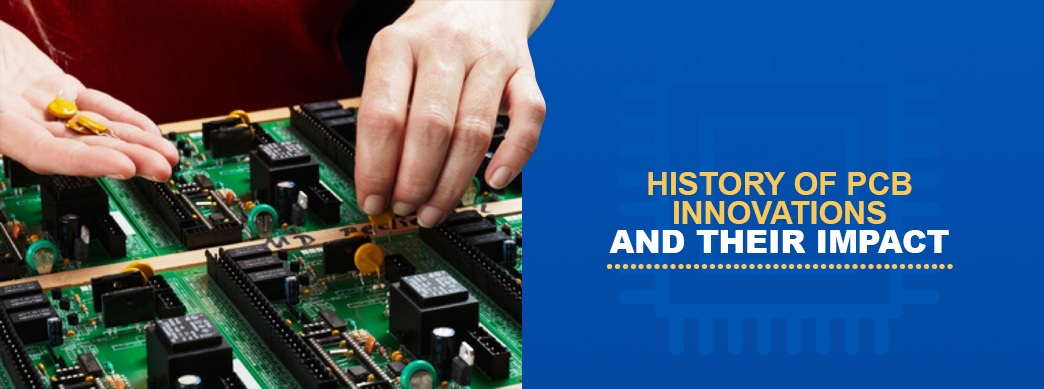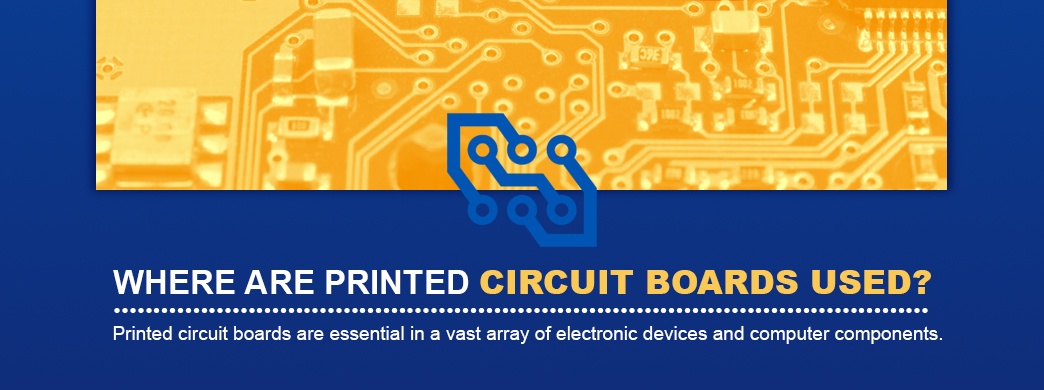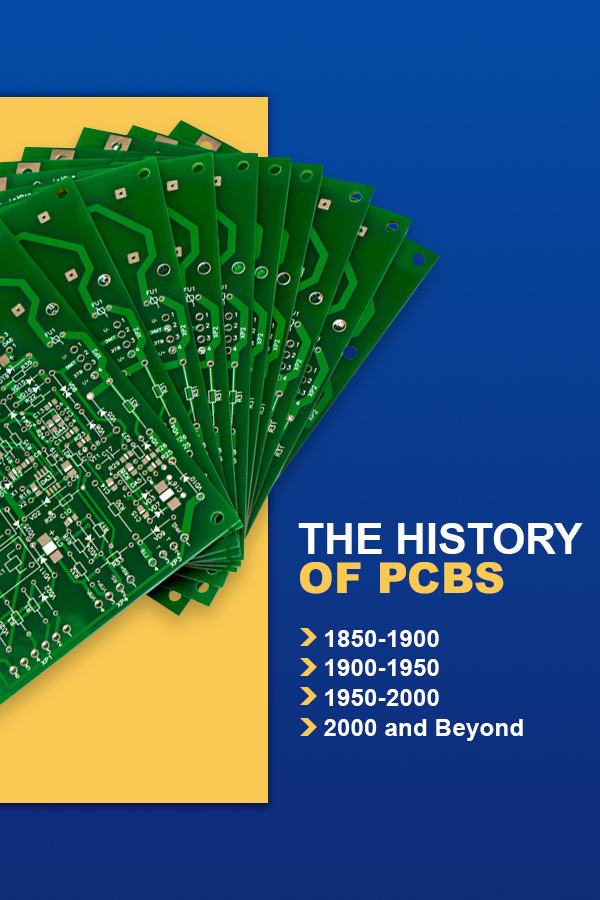Jump To: What Are Printed Circuit Boards? | Where Are Printed Circuit Boards Used | The History of PCBs | 1850-1900 | 1900-1950 | 1950-2000 | 2000 and Beyond | Quality Printed Circuit Boards
Printed circuit boards are the internal components that transmit electrical signals through electronic devices. Every time you turn on a computer or press a button on a smartphone, radio alarm or stereo component, you are interacting with a printed circuit board, which are inside the enclosures of all such devices. If electricity is the lifeblood of electronics, printed circuit boards are the vital internal organs.
In today’s heavily device-dependent world, most people are unaware of the complex circuitry contained in each smartphone or portable MP3 player. Without printed circuit boards, modern-day technology would have never become possible.
What Are Printed Circuit Boards?
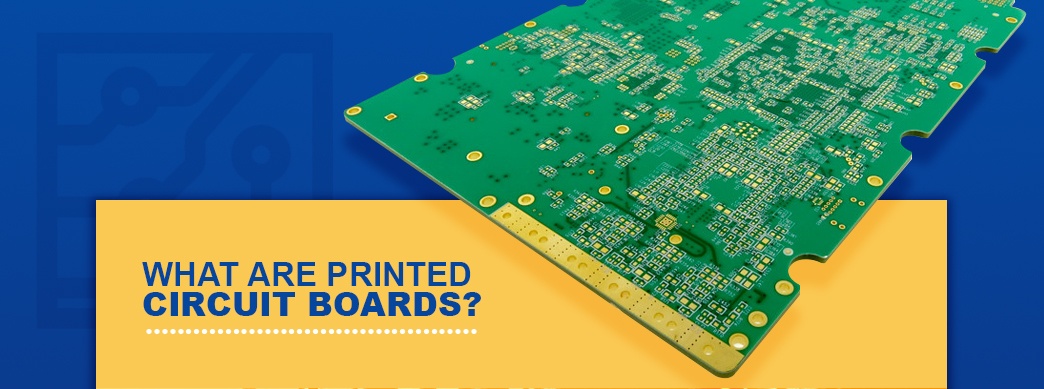
PCBs are integral to virtually all electronic devices, barring the simplest of products. The design of a PCB involves intricate circuit detail, but the assembly and production of PCBs can be uniformly implemented. Since PCBs consist of mounted, wired components with a single part, the mass production of PCBs is a straightforward, relatively inexpensive and generally error-free process, especially when compared to other wiring options like point-to-point and wire wrap.
The PCB acronym applies to both bare boards and assembled boards. If a board features copper connections, yet lacks embedded parts, the more appropriate name would be printed wiring board, despite the virtual elimination of that term from technological parlance. Other, more common, terms include printed circuit board assembly and printed circuit assembly, which is a PCB with electronic parts.
Where Are Printed Circuit Boards Used?
Printed circuit boards are essential in a vast array of electronic devices and computer components. PCBs in their modern form have been around since the 1960s, when they were components in calculators, cash registers and other simple devices with electrical circuits.
In the 1970s, PCBs began appearing in digital watches and some of the world’s first video games and personal computers. By the 1980s, PCBs were in alarm radios, video cassette recorders, Atari game consoles, CD and laserdisc players and cordless phones. During the 1990s, an increasingly advanced and miniaturized PCB was responsible for the spread of desktop computers and peripheral devices like scanners and printers among everyday Americans.
The rapid evolution of computerized devices since the late 1990s has led to smaller and smaller PCBs with greater capacity than boards from prior decades. Smartphones, for example, have grown more compact, yet damage-resistant. A similar development occurred over roughly 12 years with portable MP3 players, which advanced from the heavy, cumbersome Archos players of the early 2000s to the sleek, lightweight iPod Nano models in favor among today’s listeners on the move.
The development of chip components with greater versatility has facilitated the miniaturization of devices. With micro ball grid arrays and shorter boards, companies can now manufacture small computerized devices, knowing PCBs are sufficiently compact to fit into the enclosure at hand. This stands in contrast to earlier PCBs, where the size of the board would often dictate the size requirements of the enclosing device.
The History of PCBs
Over the past half-century, the technological components of PCBs have been quantified to micro levels. During the 1960s, the PCB in a typical calculator consisted of approximately 30 transistors. Today, the PCB in an average computer features millions of transistors within a single chip on the motherboard. These developments have made it possible to load increasing levels of functionality on tinier and tinier devices. Moreover, components such as capacitors and resistors have also shrunk to fractions of their former sizes.
The advancing capabilities modern PCBs afford have acclimated users to split-second activations on every conceivable prompt. In all likelihood, a present-day user of a PC or mobile device will grow unnerved at a mere five-second delay on a given function. Perhaps the most telltale sign of PCB evolution is in video games, which have progressed from the simple Pong systems of the 1970s to the photorealistic scenarios that enable gamers to fight and race via today’s gaming consoles.
We can trace the history of printed circuit boards back to a time long before they existed in design. The wheels were in motion the moment Benjamin Franklin flew a kite into a thunderstorm and discovered the electrical quality of lightning.
1850-1900
One hallmark of the second half of the 19th century was technological advancements by leaps and bounds. In the decades that followed the Civil War, cities up and down the East Coast and across the Midwest became equipped with electrical power, which displaced the use of heating oil and coal. As electricity spread, suburbs and rural areas were also connected to the newly formed power grid. Oil, meanwhile, nearly lost its purpose until automobiles made gasoline necessary at the turn of the century.
The spread of electrical power foreshadowed the introduction of telephones, light bulbs and consumer cameras, all of which hit the market during the final quarter of the 1800s. Even though the PCB itself did not exist within this timeframe, the technological foundations for its eventual development were almost solely rooted in the late 19th century.
1900-1950
In 1903, German inventor Albert Hanson filed the first patent for a PCB-like device that he made for use in telephone systems. The device was a flat conductor for a multi-layer insulating board. The board did have through-hole construction and conductors on both sides, just like plated through-hole PCBs today. However, devices of this type would not see widespread use in the emerging technologies of the early 20th century, a period that saw the introduction of radios, phonographs, washing machines, dryers and vacuums.
In 1927, Charles Ducas patented a version of the circuit board. He used a stencil to print wires onto a board with conductive ink, placing an electronic path right onto an insulated surface. He called it printed wiring, and it was the precursor to today’s electroplating.
Just as the naïve excess of the Gilded Age sank with the Titanic, and the horrors of the Great War humbled nationalistic sentiments, man’s biggest triumph over nature was the development of aircraft. Amid the failed experiment of Prohibition, Americans were more eager to get away from machines and head down to the nearest speakeasy for gin-soaked nights under Deco-décor lights.
The Great Depression, triggered by the stock market crash of October 1929, was a further setback to PCB evolution. The event brought the frivolity of the Jazz Age to an end and ushered a period of chain gangs, bread lines and cramped tenements where families lacked money to spend on luxury items.
The first significant adaptation of PCB-like technology occurred after the attack on Pearl Harbor in December 1941 blindsided America. Military intelligence believed they could have prevented this attack if the State Department had been better equipped to communicate with the Honolulu military base, where hints of imminent danger had loomed for some time beforehand.
As the nation became embroiled in World War II, U.S. military forces encountered a British device known as the proximity fuse, which equipped artillery shells with the capability to hit precise targets across vast stretches of land and sea.
The U.S. military ultimately embraced and adopted the concept behind the proximity fuse, enhancing the design and rendering it suitable for mass production.
Paul Eisler had a background in printing, and was captivated by the idea of printing actual electronic circuits onto boards rather than soldering the wire on by hand. Unfortunately, the Jewish Eisler was distracted by the rise of Nazism, which forced him to flee from Austria in 1936 to the not-so-friendly confines of England.
In 1941, the U.K.-based Austrian inventor, Eisler, advanced the PCB concept with a device that used copper foil on a non-conductive glass base, which is considered to be the first modern printed circuit board as the design would foreshadow modern-day top/bottom copper insulation on PCBs.
In 1943, he also introduced a PCB-equipped radio that would later prove useful in military operations.
1950-2000
With the end of World War II came a return to domesticity as American servicemen arrived back from Europe and the Far East. Frank Sinatra notched hit after hit, bobby soxers traded leg makeup for real nylons and families warmed to new inventions like the 33 rpm record album and the television set. The end of the Great Depression ushered the rise of the middle class, which spurred suburban development through the outskirts of cities and across mid-America.
The first significant post-war use of PCBs came in 1947 with the Bell Labs transistor. As Cold War tensions ramped up between the United States and the Soviet Union during the 1950s, each side had to boost its communication capabilities to stay abreast of developments on the enemy front. Just as Elvis Presley first hit TV screens shaking his pelvis to “Heartbreak Hotel,” the U.S. Army patented the “Processing of Assembling Electrical Circuits” in 1956.
For the first time, the ability to hold electricity and communicate between copper-trace components had come to fruition.
After World War II, the United States set its eyes on the final frontier: space. Printed circuit boards made space exploration possible in a way people had never considered before. Printed circuit boards significantly increase the efficiency of spacecraft, because they are low-weight and do not use a lot of electricity, even when performing very complicated tasks. Weight and energy are huge issues on a spacecraft, which is why PCBs were so popular.
The race was now on to be the first into space, which the Soviets won on several fronts by sending up the first satellite, Sputnik, in 1957. They followed up this accomplishment with the first non-manned launch to the moon and the first manned orbit of the Earth in 1959 and 1961, respectively.
In 1963 — just as the U.S. ramped its own space exploits and JFK-mourning boomers braced for the Beatles and the ensuing British Invasion — two developments occurred in PCB technology. One involved a plated hole-through technology, a Hazeltine Corp. patent that made it possible to closely space components on the same PCB with no risk of conflict. The second innovation at this time was the development of surface mount technology, courtesy of IBM. Both innovations were essential components of Saturn rocket boosters.
As the psyched-out, Technicolor 1960s gave way to the coke-fueled, wide-suited 1970s, Texas Instruments engineer Jack Kilby introduced the first microprocessor. Kilby developed the integrated circuit, which saw rapid adoption in electronics assembly. By this time, PCBs had become de rigueur in computer technology. During the second half of the decade, the first home computers hit the market, starting with the MITS Altair 8800 and IMSAI 8080 in 1975, followed by the Apple 1 in April 1976.
Though innovative for its time, the technology of the 8-track, Super 8, analog 1970s was swiftly outmoded by the high-tech advances of the surround-sound, crystal clear, digital 1980s. As Michael Jackson moonwalked generation X into the video age, the decade saw PCB-reliant devices appear in the living rooms and pockets of everyday Americans. Gadgets such as VHS recorders, compact disc players, Walkmans, cordless phones and gaming consoles all transmitted signals via PCBs. Personal computers and EDA software also made inroads during this time.
Whatever the 1990s may have lacked regarding cultural identity, it was a booming time for PCB technology. The ’90s was the decade where devices became smaller thanks to developments in PCB design that allowed more gates on single chips. As more households got connected to the Internet — first via dial up services and then, near the end of the decade, through cable and DSL lines — the personal computer became a household fixture.
Computers were no longer the big, complicated machines that set off nuclear explosions at the push of the wrong button — they were now compact, accessible, interactive devices that brought a world full of information to everyone’s fingertips. PCBs were also a significant component of cell phones, which swiftly outclassed the cordless antenna phone to become a common status symbol by the mid-’90s.
Amid the rapid technological advancements and miniaturization came an increased need to design PCBs with modification potential in mind. Whereas it was possible to modify earlier PCBs with simple rewiring, newer boards had tinier parts that were physically more difficult to alter, let alone solder. Consequently, PCB design became a more dedicated process.
2000 and Beyond
The 21st century has witnessed the innovations of the last 50 years integrated and compacted into singular, lightweight units people can carry anywhere. Whereas you once needed a separate device for each function — a phone for calls, a calculator for math, a stereo for music, a television for movies and shows, a PC for Internet access, a camera for photos, etc. — you can now perform all functions and consume any type of media on a mobile-connected laptop, pad or smartphone.
One can only guess what the future might hold for PCBs and the technology they bring to life. As talk spreads about smart homes, driverless vehicles and artificial intelligence, PCBs of various dimensions will probably be components in the automatic knobs and handles in computerized buildings and cars. Likewise, PCBs could eventually be inserted beneath the moving parts of anticipated technologies like military and co-working robots.
How Did PCBs Move From the Military to the Consumer World?
So how did printed circuit boards become what they are today, a vital part of every computer and digital device on the planet? We actually have the military to thank. The U.S. Army Signal Corps managed to figure out a way to speed up the production of PCBs with auto-assembly. This is a process wherein the manufacturer laminates a layer of copper foil to the base material and draws a wiring pattern on with acid-resistant ink. When the copper not protected by the ink is removed, the printed copper wires remain. The manufacturer then photographs the pattern onto a zinc plate to use as a model for printing more copies of the board.
This process made the creation of PCBs much, much faster, which made it highly economical for the consumer electronics industry to use them.
Quality Printed Circuit Boards From Millennium Circuits Limited
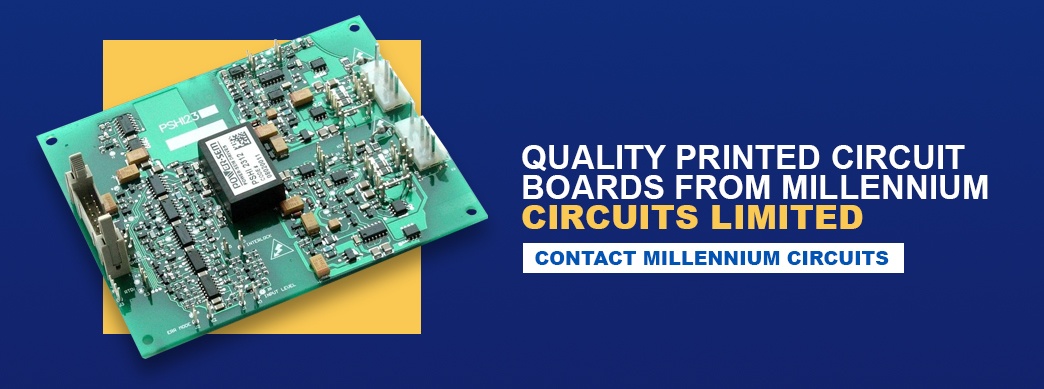
To make your mark on the next wave of tech innovation, you will need to have PCBs equipped to enact the functions in question. Contact Millennium Circuits for a quick quote on PCBs.


